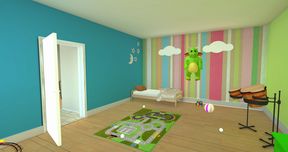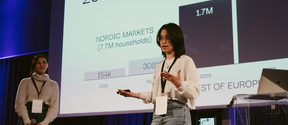Virtual reality game can assess children's ADHD symptoms

A new virtual reality game helps detect symptoms related to attention deficit hyperactivity disorder (ADHD) in children, which has been challenging with the existing tools. With further work, the game could also help treat ADHD, as well as diagnosing other conditions that disrupt attention or executive function.
ADHD affects about six percent of children globally, but the existing methods to measure its symptoms have significant shortcomings. Interviews and questionnaires are part of the evaluation, but the current most reliable objective method to tap attentional problems in ADHD is the Continuous Performance Task (CPT) test. It measures sustained and selective attention by requiring participants to keep watching a sequence of letters appearing on screen and pressing a key each time the letter is other than “X”.
‘The challenge of the symptom questionnaires is their ambiguity, while CPT doesn’t measure performance in everyday situations,’ says Juha Salmitaival, Academy research fellow at Aalto University. Together with professor of psychology Matti Laine from Åbo Akademi University and doctoral researcher Erik Seesjärvi from the University of Helsinki and Helsinki University Hospital, Salmitaival has developed a virtual reality game called EPELI (Executive Performance in Everyday Living) which simulates everyday situations and can be used to measure attention in normal conditions. The game is implemented by the Peili Vision Company in Helsinki.
Together with colleagues, the team evaluated how well EPELI could detect symptoms of ADHD. The study included 112 children aged 9 to 12, 47 of whom have ADHD. Using a head-mounted display and a hand controller, the participants moved around in a virtual apartment to perform sets of everyday tasks.
‘The participants needed to plan ahead, think how to navigate, remember the instructed tasks and avoid getting distracted by irrelevant events,’ Salmitaival explains.
The children with ADHD made noticeably more mistakes and irrelevant actions in the task than the control group. The results of the game also correlated well with the everyday challenges identified in the parent-rated questionnaires.
‘The accuracy of the game to detect attention and executive function deficits is already comparable to that of CPT, even though it’s still in early development,’ says Salmitaival, adding that an advantage of the game is the ability to tap a broader range of everyday challenges.

A better baseline
Restlessness and inattention are some of the most visible problems affecting schoolwork and everyday life in primary school-aged children. It can be difficult for parents and guardians to know whether such behaviours are a cause for concern.
‘In today's world of Netflix and mobile phones, attention-related challenges apply to all of us at some level. It can therefore be difficult for parents to assess whether their child’s behaviour is abnormal, as the assessment is always done in a bubble,’ explains Salmitaival. ‘When children's performance is tested in a game environment resembling real life, attention and executive function deficits can be determined more objectively.
Eeva Aronen, a professor of child psychiatry at the University of Helsinki, says that ‘in the future, EPELI could more objectively define a child's cognitive symptoms and behaviour in everyday life before the doctor’s appointment, which would speed up the assessment. The game could be particularly useful in monitoring the treatment effects.’
The researchers plan to develop EPELI further so that it can also be used to monitor and treat ADHD. Salmitaival explains that it could be used to monitor how changes in everyday activities, such as sleeping, affect performance. ‘From there, the next step would be for the game to provide support. It could give advice on how to cope better in everyday situations that require attention, for instance,’ he says.
A broader scope
ADHD is not the only brain disorder that is challenging to diagnose with current methods, and EPELI could help detect other similar disorders. Attention and executive function challenges occur at all ages together with conditions such as autism, mental health disorders, brain injuries and aging-related brain diseases.
Tools such as EPELI can also help relieve the pressure on overburdened healthcare systems, explains Matti Laine. The team has developed a version of EPELI that can be used remotely without virtual reality. ‘Used together with SOILE, the online testing platform we have developed, this could help alleviate the resource shortage by doing the preliminary mapping and monitoring of executive function problems directly at home,’ he says. ‘In online testing, there are no limitations on the number of participants involved.’
More information:
Seesjärvi, E., Puhakka, J., Aronen, E. T., Lipsanen, J., Mannerkoski, M., Hering, A., Zuber, S., Kliegel, M., Laine, M., & Salmi, J. (2021). Quantifying ADHD symptoms in open-ended everyday life contexts with a new virtual reality task. Journal of Attention Disorders
Link to the article (journals.sagepub.com)
Juha Salmitaival
Academy research fellow, Aalto University
juha.salmitaival@aalto.fi
Erik Seesjärvi
Doctoral researcher, University of Helsinki
erik.seesjarvi@helsinki.fi
Matti Laine
Professor, Åbo Akademi
matti.laine@abo.fi
Eeva Aronen
Professor, University of Helsinki
eeva.aronen@hus.fi
Read more news

Aalto University to host INNOVA Europe 2026 Grand Final in Espoo
Aalto University will host the INNOVA Europe 2026 Grand Final in Espoo, bringing together leading student-led startups from European universities.
Finnish AI Region Secures Second Term with Top Marks from EU
Finnish AI Region (FAIR) EDIH has been selected to continue operations for a second term with excellent ratings. European Union continuation funding enables service expansion from the beginning of 2026. Aalto University is one of 10 partners in FAIR.
UniSport services at Aalto University in spring 2026
Group excericise classes and free break excercise for students and staff at Aalto University.






